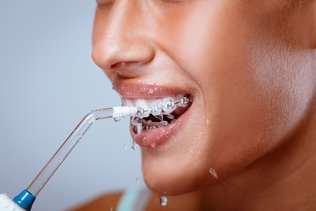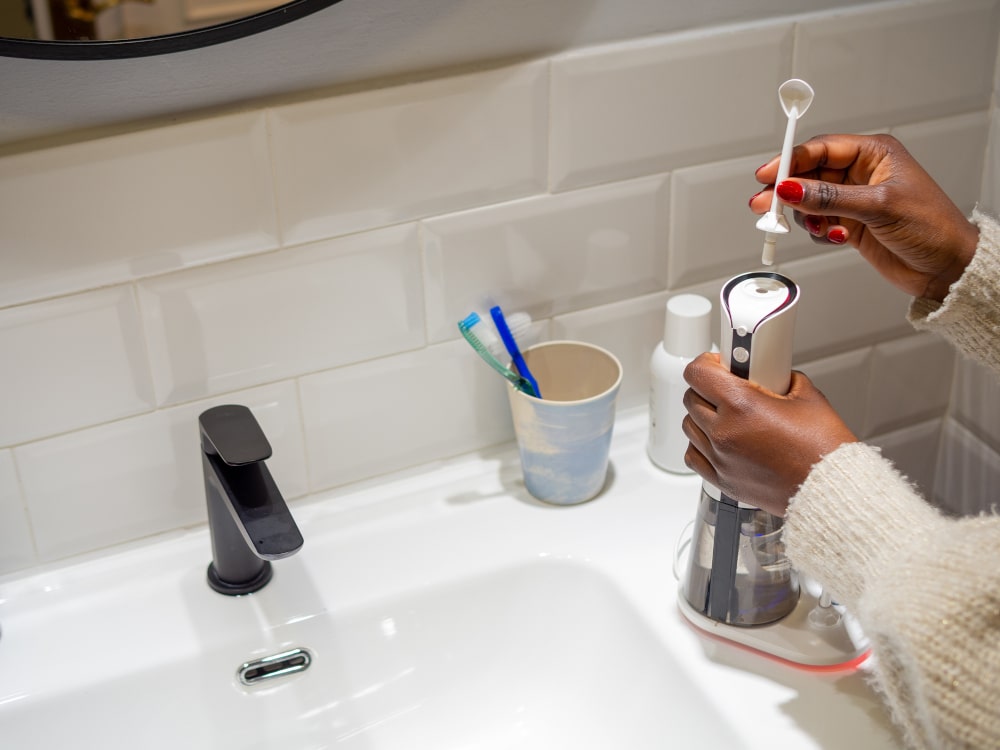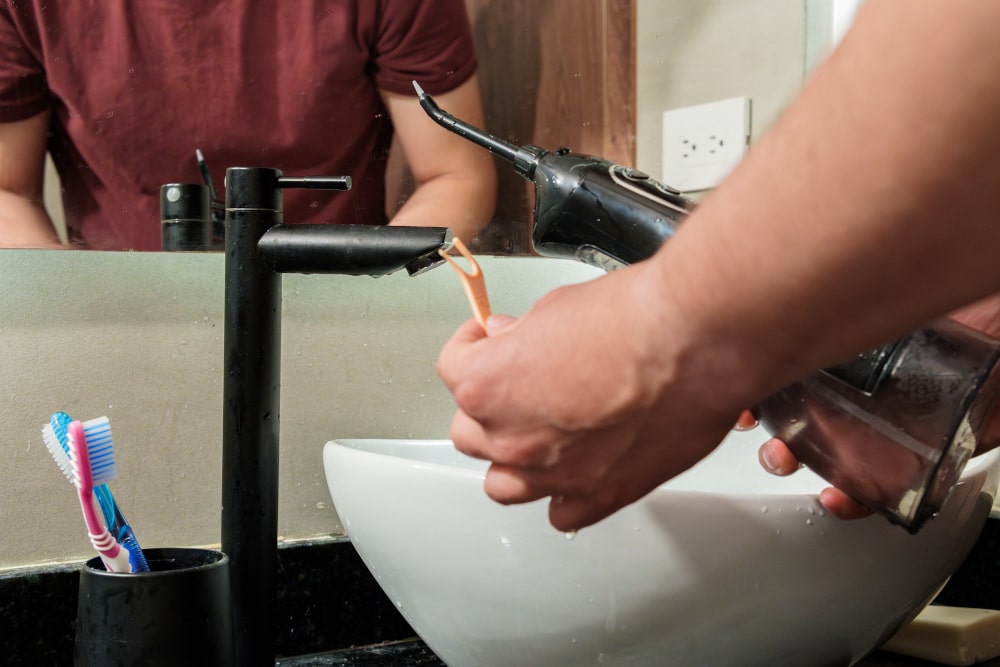
Water Flosser vs Traditional Floss: Which One Cleans Better?
Key Takeaways
- Both water flossers and traditional floss are practical tools for interdental cleaning, and both are recommended by the ADA and CDA when used correctly.
- Traditional floss offers strong mechanical plaque removal, especially in tight contact areas, but requires proper technique and dexterity to be practical and comfortable.
- Water flossers use a pressurized stream of water to clean between teeth and along the gumline, making them especially effective for:
- People with braces, implants, or bridges
- Individuals with arthritis or limited hand mobility
- Patients with sensitive gums or gingivitis
- Dentists often recommend combining both tools: traditional floss for tight gaps, and water flossers for broader or more sensitive areas.
- Choosing the best option depends on your dental condition, lifestyle, and personal preference, but daily interdental cleaning is non-negotiable for healthy gums and teeth.
What Is a Water Flosser vs. Traditional Floss?
Definitions and Mechanism
Traditional Floss is a thin strand — usually made from nylon or PTFE — used to mechanically remove plaque and debris by sliding it between teeth and against the gumline.
- How it works: You guide it up and down between teeth, wrapping around each side of the tooth surface.
- Materials: Commonly nylon (sometimes waxed) or PTFE (non-shredding).
- Users: Generally recommended for people with normal tooth spacing and no severe appliance interference.
- Dental recommendations: Dentists advocate daily use — it’s inexpensive and effective.

A water flosser (also called an oral irrigator) uses a pressurized stream of pulsating water aimed at the gumline and between teeth.
- How it works: A small motor pushes water in pulses, dislodging food particles and disrupting bacterial colonies along the gingival margin.
- Materials: Typically constructed from BPA-free plastic, with detachable water reservoirs and interchangeable tips.
- Users: Ideal for individuals with braces, bridges, implants, crowns, arthritis, or sensitive gums.
- Dental recommendations: ADA-accepted — recommended as equivalent to traditional floss for those who struggle with string floss.

How Effective Are Water Flossers in Removing Plaque and Food Particles?
Effectiveness in Research and Practice
Multiple studies show water flossers deliver meaningful plaque reduction and gingivitis improvement:
- Clinical Study (2005) – Compared water-jet flossing + brushing vs. brushing alone. Noticeable reductions in gingival bleeding and plaque after 6 weeks.
- Journal of Clinical Dentistry (2013) – Water flosser produced 29% greater reduction in bleeding and 47% greater reduction in plaque around braces compared to string floss.
Effectiveness Summary
- Reduces plaque and gingivitis significantly
- Exceptionally superior for hard-to-reach areas (braces, implants)
- Comparable to traditional floss for general use when used daily
Are Water Flossers Suitable for Individuals with Braces or Dental Implants?
Suitability for Specific Groups
- For Orthodontic Patients (Braces):
For orthodontic patients with braces, water flossers easily navigate around brackets and wires, providing more effective cleaning in areas where traditional string floss can struggle. This helps to remove plaque more effectively and reduce the risk of gum inflammation, thereby improving overall oral hygiene during orthodontic treatment. - For Implants and Bridges:
Water flossing effectively removes trapped food particles from under bridges and around implants without causing any damage to the implants or prosthetic devices. Many users share positive experiences, with some noting that their dentist recommended a water flosser after getting implants, calling it the best advice they ever received.
- For Sensitive Gums and Dexterity Issues:
For individuals with sensitive gums or dexterity challenges, many water flossers feature adjustable water pressure settings and gentle tips designed to protect delicate gum tissue. These features make them especially helpful for individuals with arthritis or limited finger flexibility.
Expert Quote
“Water flossers are an excellent adjunct too l— especially for patients with orthodontic appliances or implants.” — Dr. Amir Guorgui, DDS.
Comparison Table: Water Flosser vs. Traditional Floss
| Feature | Water Flosser | Traditional Floss |
|---|---|---|
| Mechanism | Pulsating water stream | Mechanical scraping between teeth |
| Best For | Braces, implants, bridges, and dexterity | Tight contacts, low cost, portability |
| Clinical Effectiveness | 29–47% better around appliances | Clinically proven when used correctly |
| Ease of Use | Easy — just aim at the gumline | Requires proper technique |
| Time Required | ~60 seconds once you're set up | ~2 minutes total recommended |
| Sensitivity | Adjustable pressure; safe on gums | Can cause bleeding if done poorly |
| ADA Approval | Yes, for adjunct use | Yes, the primary cleaning tool |
Is a Water Flosser Better Than Floss for Gum Health?
Comparison of Gum Health Indicators
Gum Inflammation: Water flossers have been shown to reduce inflammation more effectively in individuals with existing gingivitis, especially in hard-to-reach areas. Studies by the Journal of Clinical Dentistry report a 50% greater reduction in inflammation compared to traditional flossing in orthodontic patients.
Water flossers effectively reduce gum inflammation by reaching areas that are difficult to clean with traditional floss, such as around braces, implants, and bridges. Their gentle but thorough water jets help remove plaque and food particles that can irritate gums, leading to swelling and bleeding. With regular use, water flossers promote healthier gums by improving blood circulation and reducing bacteria buildup. They are especially beneficial for individuals who find traditional flossing challenging due to limited dexterity, sensitive gums, or the presence of orthodontic appliances. Overall, water flossers provide a convenient and comfortable way to maintain optimal oral hygiene and support gum health.
What Are the Main Benefits of Using a Water Flosser Daily?
Efficiency and Accessibility
Time Efficiency: Most users can complete a full session in under 60 seconds. This convenience increases compliance compared to traditional flossing.
Ease of Use: Requires less dexterity and no fine motor manipulation — just aim and activate. This makes it ideal for elderly users or those with arthritis.
Accessibility: The pulsating stream reaches periodontal pockets and behind molars more easily than string floss, which often misses angled areas.
Daily Use Benefits Table
| Benefit | Water Flosser |
|---|---|
| Time Required | ~60 seconds |
| Accessibility | Excellent for hard-to-reach and subgingival areas |
| User Friendly | Yes—simple trigger or switch operation |
| Daily Plaque Removal | High (when used consistently) |
| Suitable for Everyone | Especially good for orthodontic and elderly patients |
Can Traditional Floss Remove Plaque as Effectively as Water Flossers?
Mechanism and Technique
Mechanical Action: Traditional floss removes plaque via friction, scraping along the surface of the tooth and gumline. It’s most effective when used with proper technique, including a gentle “C” shape, an up-and-down motion, and careful insertion.
Pros and Cons
| Factor | Traditional Floss | Water Flosser |
|---|---|---|
| Plaque Removal | High (with proper use) | High (especially in subgingival areas) |
| Technique Sensitive | Yes | No |
| Portability | Very high | Requires device, charger |
| Comfort | It can be painful if mishandled | Generally gentler |
| Appliance Friendly | Difficult with braces, implants | Ideal for all dental appliances |

What Do Dentists Recommend for Optimal Interdental Cleaning?
Professional Guidelines and Oral Hygiene Strategies
ADA Recommendations:
- The American Dental Association (ADA) and Canadian Dental Association (CDA) both recommend daily interdental cleaning.
- ADA states: “Interdental cleaners such as floss and water flossers are essential for cleaning between teeth.”
Age-Related Advice:
- Children & Teens: Supervised flossing recommended. Water flossers can be helpful if compliance is poor.
- Adults: Either method is acceptable as long as it’s done daily and properly.
- Seniors: Water flossers are favoured due to arthritis or limited manual dexterity.
General Hygiene Tips:
- Combine brushing twice daily with interdental cleaning once a day.
- Use ADA/CDA-approved products.
- For orthodontic cases, use floss threaders or water flossers to avoid food traps.
What Are the Pros and Cons of Water Flossers vs Regular Flossing?
Comparative Analysis
| Aspect | Water Flosser | Traditional Floss |
|---|---|---|
| Usability | Easy for all ages, especially those with limited mobility | Requires coordination and precision |
| Effectiveness | Excellent for implants, braces, and sensitive gums | Excellent in tight contacts |
| Comfort | Gentle and soothing | Can irritate gums if misused |
| Portability | Needs charging, less portable | Lightweight and ultra-portable |
| Noise | Can be noisy (motorized) | Silent |
Can Water Flossers Fully Replace Traditional Flossing?
Hybrid Solutions and Professional Input
Hybrid Approach:
- Many dentists recommend using both tools: string floss for tight contacts, water flossers for subgingival or appliance cleaning.
Situational Preferences:
- For patients with braces, implants, or arthritis, water flossers may be a superior option.
- For minimal dental work and healthy gums, traditional floss remains an effective option.
Authoritative Data:
- ADA and CDA support both tools when used correctly.
- Studies show that water flossers lead to greater compliance and user satisfaction, but neither tool is universally superior in every case.

